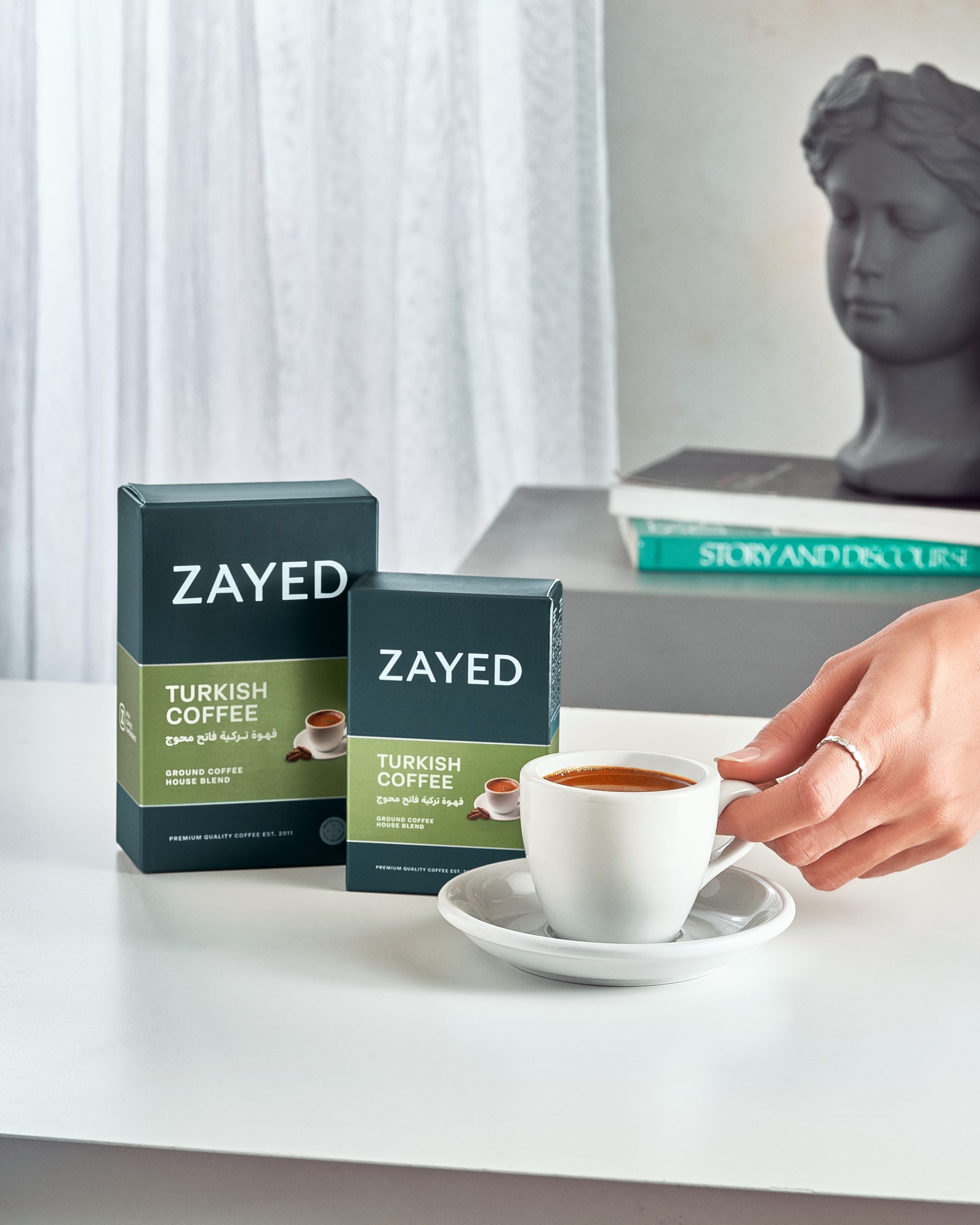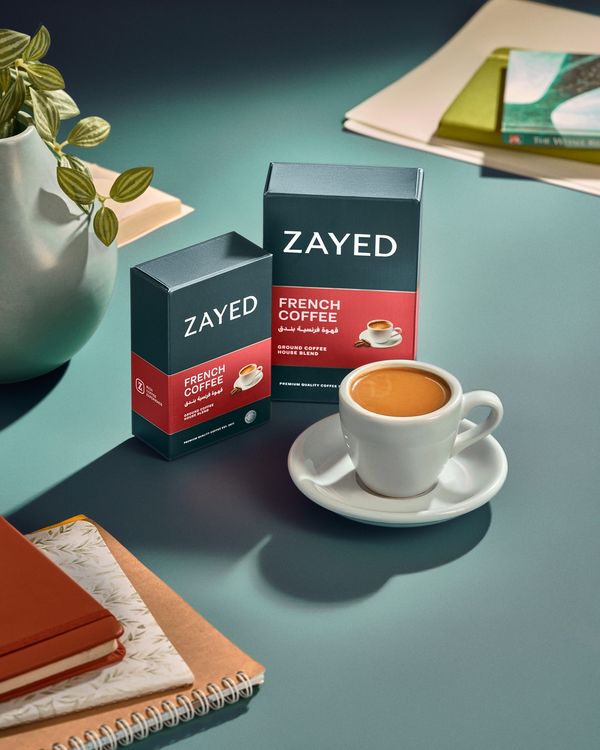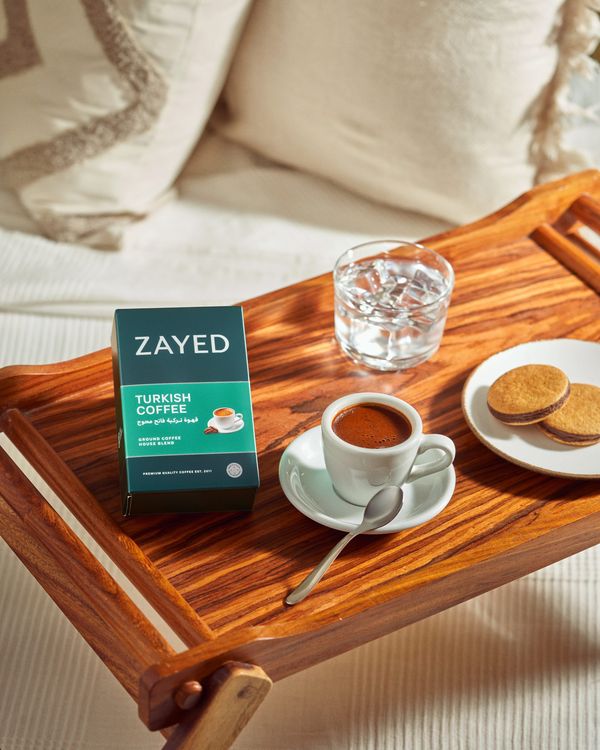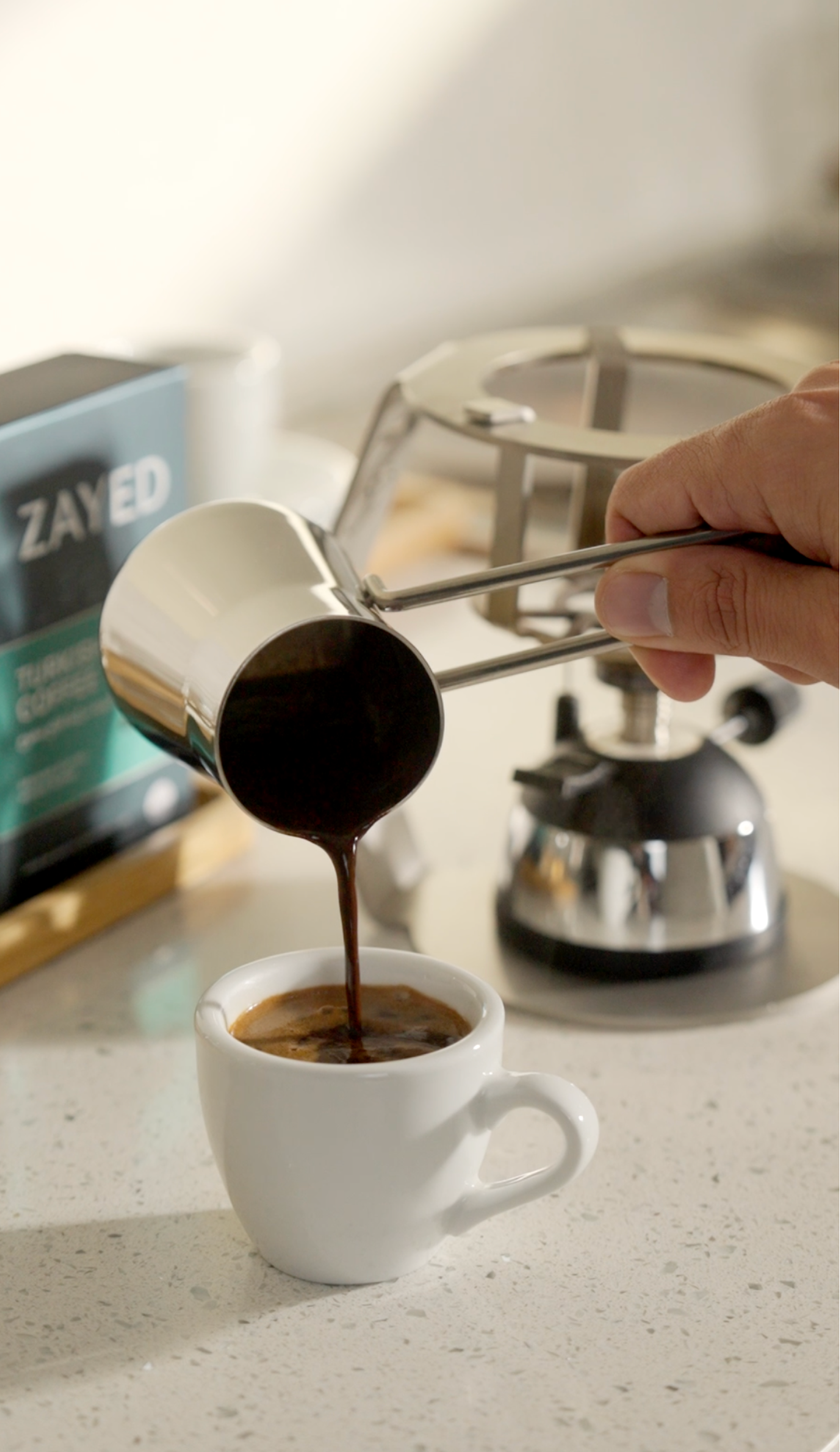المحتويات
- القهوة في مدن مختلفة من حول العالم
- كيف للقهوة أن تكون مشروب عالمي؟
- كيف يواكب زايد ما يحدث بالعالم بعقل منفتح ؟ و ما هي أهم الدول التي نستورد منها؟
القهوة هي مشروب ساخن أو بارد، يتم اعدادها من الحبوب المحمصة والمطحونة ، و لكن هل هي بمثل تلك البساطة؟
في الحقيقة انها بسيطة ومعقدة في آن واحد، حيث ان طريقة إعدادها و تقديمها تختلف من دولة إلى أخرى فكل دولة لها ثقافتها الخاصة عن القهوة ، قد يكون هذا غريبا بعض الشيء بالنسبة لك إذا كنت تعتقد أن القهوة هي نفسها القهوة بكل مكان بالعالم لكنها في الحقيقة ليست كذلك ، تعال معنا لترى القهوة بعيون العالم .
- القهوة في مدن مختلفة من حول العالم:
- تركيا
القهوة التركية مشهورة بكل أنحاء العالم ، يتم اعدادها بكنكةِ القهوة الخاصة بها انه عُرف إعداد القهوة التركية وهي عبارة عن وعاء صغير من النحاس أو النحاس الأصفر، هناك العديد من التعقيدات التي تميز تحضير القهوة التركية، اولا يتم إضافة السكر أثناء مرحلة التخمير فلا تحتاج إلى استخدام ملعقة للتقليب فيما بعد، ثانيا ليس هناك حليب او كريمة مضافة، يتم إعداد فنجان القهوة من حبوب البن المنتقاة فقط ، و بالاقتراب من الغليان يتم تشكيل رغوة أو ما يُسمي “وجه القهوة” و هذا الجزء بالتحديد يعتبر هام لقهوة مثالية، لذا حافظ علي قهوتك مستقرة و لا تقوم بتحريكها كثير حتى لا تضيع الرغوة ، و الهيل يضيف نكهة خاصة الى الخليط، القهوة التركية مُعدة من حبوب الأرابيكا فهي قهوة جيدة مطحونة في شكلها الحبي الناعم “مسحوق من القهوة” وعادة ما يتم إضافة الهيل أثناء عملية طحن البن، ويمكن أيضا غلي حبوب كاملة منه و تركها تطفو على السطح عند التقديم، كما أن تحلية القهوة التركية لها ٦ مستويات بالتدريج من كونها حلوة جدا الى كونها بلا سكر “سادة” حيث أن السكر لا يُضاف للقهوة بعد أن يتم تقديمها فلا نحتاج للملاعق بعد ذلك، فعند اقتراب القهوة من الغليان يتم تكوين ذلن السطح الرغوي “الوجه” . و هناك قواعد لحفلات القهوة التركي تنص إحدى تلك القواعد على أنه إذا غابت الرغوة عن وجه القهوة ، يفقد المضيف وجهه” أي يشعر بالإحراج” انها قاعدة هامة في تحضير قهوة تركية مثالية.
- السويد “كافوست” أو القهوة بالجبن
الجميع يحب الجبن، أنه يناسب كل شيء تقريبا ولكن هل يناسب القهوة “ممتزجا بالقهوة نفسها” ؟
و هل أنت شجاع كفاية لمزجِ الاثنين معا؟ وهل سيصبح الخليط جيد؟ يمكننا أن نعرف سويا، الان قم بتحضير قهوتك و نوعك المفضل من الجبن و امنحها تجربة كما سنفعل نحن أيضا.
لكن، لما الجبن بالقهوة؟ انه من غير المألوف و الغريب أن تضع قطع الجبن بقهوتك ولكنه شيء تقليدي بالسويد أن تفعل ذلك.
عندما نأتي لجزء انغماس قطع الجبن بالقهوة الساخنة، أنه يمنح مذاق القهوة ثقل أفضل، حيث يتحول مذاق القهوة لشيء أكثر نعومة حيث تكون قطع الجبن تلك كإضافة كريمة لقهوتك، فتكون كل رشفة بنكهة الزبده كما تضفي قطع الجبن مذاقا يشبه البندق.
والأن إلى الجزء الأكثر حماسا، كيف نصنع كوبا من قهوة الجبن او “الكافوست”؟
لكي تقوم بإعداد الكافوست ستحتاج إلى وضع الجبن بقاع كوبك اولا حيث تكون على شكل طبقة تغطي ذلك القاع، و يتم سكب القهوة المخمرة علي قطع الجبن حتى تتأكد من أن طعم الجبن سيتغلغل بالقهوة و من المفضل أيضا عند صنع الكافوست أن يتم وضع قطع الجبن بالميكروويف قليلا في البداية فهذا بدوره يساعد علي اكساب القهوة فيما بعد مذاق اكثر نعومة، فيكون مذاق القهوة بذلك أفضل كثيرا.
ومن أجل مذاق افضل بعد للكافوست خاصتك قم بإضافة الحليب أو الكريمة المخفوقة للخليط ، فهذا المزيج من الجبن والحليب سيجعلك تعيش بعالم كريمي من القهوة يمكنك أيضا مشاهدة هذا الفيديو لتتعلم أكثر عن طرق اعداد الكافوست:
- اليونان “الفرابيه”
الفرابيه اليوناني هو بلا شك أكثر أنواع القهوة انتشارا باليونان خاصة بوقتِ الصيف، فعندما تحتاج إلى مشروب بارد و طازج فهو خيارك الأمثل، البعض يطلق على الفرابيه “مشروب اليونان الوطني” و هذا حقيقي بالتأكيد، حيث انه يتم تقديمه بكل مكان باليونان ، فتري الأصدقاء يرتشفون الفرابيه المثلج المفضل لديهم وهم في حالة من الاسترخاء هذا ما يُسمى بأسلوب الحياة اليوناني.
تاريخ الفرابيه اليوناني:
الفرابيه اليوناني او نسكافيه فرابيه، تم اختراع عام ١٩٥٧م في “ثيسالونيكي” بالمعرض التجاري الدولي ، عندما قام “يانيس دريتساس”ممثل شركة نسكافيه بافتتاح منتج جديد للأطفال كان المنتج هو مشروب شيكولاتة، حيث يتم إنتاجه على الفور بعد سكب اللبن و خفقه بجهاز للخفق، “ديميتريس فاكونديوس” كان يبحث عن طريقة لصنع قهوة سريعة الذوبان أثناء فترة راحته، لكنه لم يجد ماءًا ساخنًا فقرر أن يدمج قهوة سريعة الذوبان مع ماء بارد و قطع من مكعبات الثلج و اعدادهم بخلاط .
كيف تقوم بإعداد افضل فرابيه على طريقة زايد؟
لتقوم بإعداد فرابيه يوناني ستحتاج إلى خلاط للفرابيهِ، و ان كان لديك خلاط الكوكتيل التقليدي سيفي ذلك بالغرض، ويمكن أيضا أن تستخدم دمج الحليب الكهربائي او ماكينة خفق الحليب لصنع رغوة من الكريمة.
و نجد انه أفضل طريقة لإعداد الفرابيه هي باستخدام كوبا طويلا من الزجاج ومن ثم قم بإضافة القهوة سريعة الذوبان و السكر و الماء البارد قم بخفق الخليط حتي يتم صنع رغوة كريمية سميكة، ومن ثم قم بسكب الخليط بكوب التقديم و أضف ٣ مكعبات من الثلج و اللبن إن أحببت، وقم بملئ الكوب بالماء البارد و ضع الماصة “الشاليموه” بالكوب و تذكر أن تستخدم مواد صديقة للبيئة ، نمزح معك نعلم انك ستفعل ذلك، اهم شيء ان تستمتع بكوبِك من الفرابيه.
- المكسيك “كافيه دي أولا” “Café de Olla”
تلك القهوة المكسيكية الغنية بالتوابل، والتي تُعرف باسم “”كافيه دي أولا” “Café de Olla”
يتم إعدادها من حبوب القهوة المكسيكية و القرفة و السكر الأسود الخام الذي يُطلق عليه “بيلونسيلو” انها وصفة تقليدية بالمكسيك، فتلك الوصفة الأصلية هي بسيطة وسهلة للصنع، إنها تأخذ حوالي ١٥ دقيقة من بدايتها حتي نهايتها، و ستكون سعيدا جدا بعد اعدادك لها لانها لذيذة جدا، غنية بالمذاق والرائحة و بداية مثالية لنهارك.
هل تريد أن تعلم كيف تصنع وصفة كتلك؟ سنخبرُك بكل تأكيد
المكونات و البدائل:
القهوة : الخيار الأفضل سيكون القهوة المكسيكية مثل “فيراكروز ، أواكساكا ، تاباسكو ، إلى آخره” لكن في الحقيقة أي نوع قهوة عالي الجودة سيفي بالغرض
محلي : عادة يتم تحلية هذا المشروب بسكر “بيلونسيلو” لكن احيانا من الصعب العثور عليه بأي مكان لذا من الممكن أن تستبدله بسكر بني غامق ولكن الاختيار الأول هو الأفضل بشكل كبير .
التوابل : القرفة هي شيء لا يمكن أن يُنسي بالوصفة، وهذا هو المكون الذي نُحبذ ألا يتم استبداله ، حيث يمكنك استخدام اي نوع ان لم تجد القرفة المكيسيكية حتي انه يمكنك اضافة القرفة المطحونة.
الإضافات : إذا أردت أن تأخذ قهوتك المكسيكية الى مستوى آخر قم بإضافة القليل من بودرة الكاكاو ، انه يضيف مذاق لذيذ حقا ، وإن أردت المزيد من ثراء الطعم قم بإضافة “Kahlúa”
لا تعرف ما معنى “Kahlúa” أنه من الصعب التعرف عليها سنخبرك لا تقلق
“Kahlúa” هي قهو مُعدة من حبوب الأرابيكا بنسبة ١٠٠٪ و هذا ما يمكنك أن تجده في زايد.
و الان الي طريقة الاعداد “الخطوات”:
قم بوضع الماء في وعاء متوسط الحجم ، يمكنك استخدام أي نوع من الأواني المتاحة بمنزلك، لكن انتبه فقط ان يكون ملائم لعمل ٨ أكواب من الماء
قم بإضافة سكر “بيلونسيلو” (قصب السكر أو الدبس) و أعواد القرفة و اليانسون والقرنفل ويقلب جيدا
اترك الماء يغلي ثم اتركه على نار هادئة لمدة ٥ دقائق مع التقليب للسماح للبيلونسيلو بالذوبان والتوابل لإطلاق رائحتها.
صب من خلال مصفاة أو القماش القطني لتقديمه في أكواب. أو احتفظ بها دافئة وقدمها لاحقًا.
- فيتنام “Ca Phe Da.” “كا في دا”
تاريخ “كافي دا” آو “Ca Phe Da” قادم من فرنسا حيث إن تلك الكلمة مستعارة ن الفرنسية للدلالة على المقهى بنطق مشابه، في منتصف القرن التاسع عشر كانت القهوة هي مشروب منتشر بين القساوسة و الجنود الفرنسيين لكن استيراد اللبن الطازج كان مستحيلا بسبب المسافة البعيدة و الجو الحار، تسبب نقص الحليب في مشروبهم المفضل في الشعور بالحنين إلى الوطن ، مما أدى إلى استخدام الحليب المكثف كبديل مناسب.
استمر الوضع العالمي في التأثير بعمق على إنتاج القهوة وثقافتها، قبل الحرب العالمية الأولى ، كانت القهوة رفاهية في متناول الفرنسيين والطبقات العليا فقط، ومع ذلك ، أدى اندلاع الحرب إلى انخفاض كبير في أسعار البن ، مما جعلها في متناول الشعب الفيتنامي ومع الوقت، أدت وتيرة الحياة المحلية والاحتياجات البسيطة لتناول مشروب إلى تحويل القهوة إلى مشروب يومي أقل تزيينيًا مقارنة بالقهوة على الطريقة الغربية. إن سعره المنخفض وطعمه الجيد وسهولة تحضيره جعله أحد أكثر المشروبات المفضلة في فيتنام.
أنواع قهوة “Ca Phe Da.” “كا في دا”:
قهوة “كا في دا” في سايجون : هناك تنوع بقهوة “كا في دا” في سايجون من ضمنها ما يُسمي ب “bac xiu – القهوة البيضاء” و ما يُسمي ب “ca phe sua tuoi- قهوة اللبن الطازج” و تُعد قهوة “bac xiu” نسخة غنية بالحليب من أجل أولئك الذين يملكون حساسية للكافيين، بينما “ca phe sua tuoi” تُعد من الحليب الطازج.
قهوة “Ca phe nau” في هانوي: اول شيء ملحوظ هنا سيكون في تسمية المشروب ، ففي عاصمة هانوي يشير الناس إلى “ca phe den” باسم ” den nong” اي قهوة سوداء ساخنة، يطلقون على قهوة “ca phe sua” اسم
“nau nong” اي قهوة بنية ساخنة ، وهناك تنوعُ آخر شعبي في هانوي وهي قهوة “ca phe trung” اي قهوة البيض ، وهي مزيج فريد من القهوة والحليب المكثف المحلى مع البيض ، قد يبدو من غير التقليدي دمج كلا من القهوة والبيض معا ، لكن النتيجة هي انسجام متوازن بين النكهات ،الطعم القوي للقهوةِ الفيتنامية السوداء التقليدية يبدأ بالظهور من خلال طبقة البيض المضافة والتي تضفي لمسة من الحلاوة.
كيف تقوم بإعداد كوب من قهوة الـ “Ca Phe Da.” “كا في دا”؟
المكونات:
مرشح من الألومنيوم أو الإينوكس
قهوة ذات جودة عالية “من المفضل أن تكون روبوستا”
حليب مكثف
ثلج
ماء مغلي
كوب زجاجي و ملعقة طعام
الخطوات:
- قم بغسل المرشح و الكوب الزجاجي و هذا للمساعدة في التقاط رائحة القهوة بشكل أفضل.
- قم بإضافة من ٣-٤ ملاعق طعام من الحليب المكثف الى الكوب يمكنك إضافة المزيد فيما بعد بما يلائمك
- قم بإضافة من ٢-٣ ملاعق طعام من البنِ الي المرشح ، قم بتحريك الفلتر بلطف حتى يتم انتشار القهوة بشكل متساوي ثم ضع قرص الضغط فوق القهوة.
- قم بسكب من ١-٢ ملعقة طعام من الماء المغلي بالفلتر بما يلائم تغطية وجه القهوة وانتظر دقيقة واحدة ، هذه العملية تسمى باسم “التفتح أو الإزهار” وهو ما يؤدي إلى ترطيب القهوة المطحونة و تقطيرها اللذيذ.
- املأ الفلتر ببطء إلى الأعلى بالماء الساخن وانتظر (أو شاهده) وهو يقطر. قد يستغرق هذا التنقيط من٥ إلى ١٠ دقائق، تذكر أن تغلق غطاء الفلتر حتى لا تفلت رائحة القهوة القوية.
- عندما تتوقف القهوة عن التنقيط أو التقطير قم بتقليبها جيدا و ان كانت القهوة كثيفة المرارة بهذه المرحلة قم بإضافة المزيد من الحليب المكثف.
- قم بإضافة الثلج و استمتع.
- إثيوبيا “إثيوبيا جينيكا”
ما الذي يجعل القهوة الإثيوبية مختلفة؟ إن إثيوبيا تقوم بإنتاج القهوة من مئات السنين ، أن إثيوبيا نفسها هي منشأ نبات قهوة الأرابيكا، وحوالي ٦٠٪ من إنتاج العالم من القهوة يأتي من نباتهم، و لكن ما الذي يجعل حبوب القهوة الإثيوبية مميزة الى هذا الحد؟ أن حبوب القهوة الأثيوبية تصنع المشروب بمذاق أكثر تعقيدا و ملمس حريرا ناعما، كما أن النكهات أكثر إشراقا مع لمسات من الحموضة والنكهات الكاملة.
فمن حيث المذاق والجودة فالقهوة الإثيوبية هي واحدة من أفضل أنواع القهوة أحادية المنشأ بالعالم، لهذا في زايد نفضل حبوب القهوة الإثيوبية أكثر من الأنواع الأخري.
كم نوعا من القهوة الإثيوبية موجود بالعالم؟
سيدامو: يُعتقد أنه مصدر نشأة القهوة. من المعروف أن حبوب البن الأثيوبية هذه تحتوي على روائح الليمون و طعم حمضي.
حرار: هي من المفضلات بين عشاق القهوة. تزرع حبوب البن الإثيوبي من منطقة هرار على ارتفاعات عالية. هذا يعطي القهوة الحمضيات والنوتات الزهرية اللازمة ، على غرار أنواع القهوة الإثيوبية الطبيعية الأخرى ، ولكن بثراء وكثافة أكبر.
جينيكا: القهوة الناضجة في تلك المنطقة هي عادة ما تُعرف بإثيوبيا جينيكا، وهي نوع من قهوة الأرابيكاَ أحادية المنشأ وهذه الحبوب الإثيوبية هي صغيرة و مزخرفة المظهر، لكنها تحوي نكهة عميقة غنية تُذكرنا بطعم الشيكولاتة و الخمر، وبعض محبي القهوة يلاحظون بأن هذه القهوة الإثيوبية الطبيعية بها لمسات من نكهة التوابل.
كيف تقوم بتخمير حبوب القهوة الإثيوبية الطبيعية؟
- طريقة التخمير الباردة
التخمير البارد للقهوةِ يتطلب أقل المجهود و التحضيرات، انت فقط تحتاج إلي مرشح أو مصفاة وال جرة كبيرة من اي نوع،من السهل أيضًا التعود على هذه الطريقة ، لكنها تتطلب الصبر. هناك نسبة جيدة لتبدأ بها وهي خلط جزء واحد من القهوة الإثيوبية مع ٤ أجزاء من الماء.
وهنا حيث يأتي دور الصبر في اللعبة، اترك خليط التخمير البارد خاصتك لمدة ما بين ٨-١٢ ساعة ولا ننصح بتخطي تلك المدة وهذا لأنها ستؤثر على منتج القهوة خاصتك.
بعد تحقيق عامل الوقت ، قم بفلترة حبوب القهوة وستحصل في النهاية علي قهوة إثيوبية باردة مخمرة لذيذة قم بحفظها في الثلاجة للحفاظ عليها باردة او قم بإضافة بعض مكعبات الثلج واستمتع.
- طريقة الـ “french press”:
إنها الطريقة المثالية للناس المشغولين هذه الطريقة تسمح لحبوب القهوة الإثيوبية بأن يتم تخميرها أو غمرها، في ماء ساخن قبل التقديم، وهنا الهوة الإثيوبية لا تحتاج الى وقت طويل للإعداد أو الانتظار، رغم ذلك يجب ان تكون عملية إزهار أو نضج القهوة ٣٠ ثانية و ان تكون مدة الغمر حوالي ٤ دقائق
- طريقة الصب:
قد يستغرق الأمر بعض الوقت قبل أن تتعود على الأمر ولكن بمجرد أن تفعل ذلك ، ستشكر نفسك على كل مشروب جيد تصنعه، يرى البعض أن صنع القهوة على طريقة الصب هي علمًا ، بل ويستخدمون مؤقتًا وميزانًا لتحضير فنجان مثالي في الصباح. إنها طريقة رائعة للحصول
على بعض التركيز قبل التعامل مع اليوم، والنسبة الموصى بها من القهوة إلى الماء هي ١:١٦ بمجرد وزن قهوتك وماءك ، يمكنك البدء في تحضير القهوة
- النمسا: “وينر ميلانج “Weiner Mélang”
غالبًا ما يتم مقارنتها بالكابتشينو، “وينر ميلانج” هي مزيج خاص من القهوة والحليب يشبه إلى حد كبير قهوة اللاتيه ، يعود تاريخ أول تسجيلات مكتوبة حولها إلى فيينا في منتصف القرن التاسع عشر، بينما تأتي كلمة “ميلانج-Mélang” من الفعل الفرنسي “méler” والذي يعني “دمج أو خلط” وبينما يوجد تنوع بهذا المشروب الكلاسيكي إلا أنه عادة ما يتم تحضيره من جرعة إسبريسو واحدة من القهوة الخفيفة التي يتم تقديمها في فنجان كبير، ومن ثم يتم وضع لبن كريمي ساخن علي وجه القهوة و رغوة الحليب أيضا، ميلانج يتم استهلاكها عادة عن طريق إحتساءِ رغوة الحليب ويتم تحضير كوب من الماء بجانبه ليعمل كفاصل بين الرشفات، هذا المشروب هو عنصر أساسي في مقاهي فيينا، و يتم تحليته بناءًا على الرغبة الشخصية لكل فرد، للحصول على تجربة كاملة يتم تقديمها مع الحلويات النمساوية.
- البرازيل “كافيزينيو” “Cafezinho”
ما هو ال “كافيزينيو” “Cafezinho”؟
هو مشروب قهوة تقليدي يتم تقديمه بشكل شائع في جميع أنحاء البرازيل. يتم صنعه عن طريق إضافة السكر إلى القهوة السوداء.وهو عادة ما يتم تقديمه باللون الأسود “كالقهوة السوداء” انه من المعتاد ان يقوم شاربي القهوة بإضافة اللبن أو الكريمة لتخفيف المذاق و إضافة سمكا لملمس القهوة.
ما الذي يجعل “كافيزينيو” “Cafezinho” مهم ثقافيا “علامة ثقافية” ؟
هناك سببا وراء كتابة فرانك سيناترا اغنية بعنوان “”هناك كمية هائلة من القهوة في البرازيل.” لقد كانت البرازيل دولة محبة للقهوة، ومن الواضح أن مشروبات الكافيين متغلغلة بكل المقاييس في مجتمعاتهم.
كيف تقوم بإعدادها؟
المكونات:
٤ أكواب من الماء المفلتر
٤ ملاعق طعام من حبوب القهوة عالية الجودة “حبوب الاسبريسو”
٣-٤ ملاعق طعام من السكر او من نوع “رابا دورا”
لبن أو كريمة من أجل المذاق “اختياري”
المعدات:
إناء لغلي الماء
كوب للتقديم
فلتر ورقي أو من القماش
الخطوات:
- قم بغلي الماء والسكر، ابدأ بإضافة الماء والسكر إلى القدر ووضعهما على نار عالية. اترك الماء ليغلي.
- قم بإزالة الإناء عن النار و أضف حبات القهوة، يرفع الخليط عن النار بمجرد الوصول إلى درجة الغليان. ثم تضاف القهوة المطحونة ويقلب لمدة ١٥-٢٠ ثانية.
- قم بفلترة الخليط، قم بسكب خليط القهوة خاصتك خلال الفلتر
- قم بإضافة اللبن أو الكريمة وقدمه، اذا احببت أن تضيف لبن او كريمة قم بذلك لمذاقِ أخف و من ثم قم بالتقديم على الفور.
ما نوع القهوة الذي يجب أن أستخدمه؟
يمكنك استخدام أي نوع تريد لكن احرص أن يكون ذو جودة عالية.
- أيرلندا: “قهوة إيرلندية”
تعتبر القهوة الأيرلندية مدفأة في فصل الشتاء ، وهي مثالية لأي شخص يبحث عن القهوة قوية المذاق فهي مُعدة من القهوة الساخنة والويسكي الأيرلندي والكريمة السميكة ، اخترع المشروب رجل يدعى جوزيف شيريدان في عام ١٩٤٢م.
- إيطاليا: “أفوُجاتو” “Affogato”
أفوُجاتو هو جيلاتو غارق في الإسبريسو. وصفة حلوى سهلة وسريعة تتناوُلها بالملعقة. انها وصفة مثالية في أي موسم ولأي مناسبة ،إذا كنت تحب نكهة الآيس كريم الحلو و القشدي ، وتختلط مع النكهة القوية للِإسبريسو، فإن Affogato هو الخيار المناسب لك.
الأن سنريك الوصفة الأصلية للآفوُجاتو:
وقت التحضير: ٥ دقائق
وقت الطهي: ٥ دقائق لتحضير الإسبريسو
التقديم: كوب واحد
المكونات:
١ مغرفة من الآيس كريم
كوب من الإسبريسو “حوالي ٤٠ ملي”
أنت بحاجة إلى آلة إسبريسوُ جيدة مع كبسولات تلائم استخدام الجرعة الواحدة. أو الاستخدام التقليدي
تعتبر أكواب الإسبريسو مهمة أيضًا في تحديد كمية جرعات القهوة. يجب ألا تكون القهوة أكثر من اللازم ، مقارنة بكمية الآيس كريم.
الخطوات:
- قم بتبريد كوب الحلوى أو كوب التقديم
- تأكد من أن الأيس كريم بارد تماما
- قم بإضافة بولات كن الأيس كريم الي الكوب المبرد
- قم بتخمير الإسبريسو قبل التقديم مباشرة
- إما أن تصب الإسبريسو فوق الآيس كريم وتقدم على الفور ، أو تقدم الإسبريسو على الجانب ودع ضيوفك يصبونها بأنفسهم
كيف للقهوة أن تكون مشروب عالمي؟
كما رأينا بالأعلى ، القهوة ليست فقط مشروب عالمي إنما هي مشروب تقليدي بكل أنحاء العالم ، إنها بكل مكان و بطرق متعددة في طريقة التقديم، و ما هو رائع بخصوص القهوة هو قابليتها العجيبة في اعادة تشكيل نفسها لتلائم كل ثقافة كما لو تستطيع أت تغير من جلدها بطريقة مختلفة كل مرة، ونحن في زايد نريد أن نكون بتلك المرونة تمام مثل القهوة ، فنحن لا نستورد القهوة و نقوم بصناعتها فقط بل نتعلم من القهوة حول العالم، و نستمر بالتعلم، فإذا شعرت بأنك تريد الانضمام معنا بالرحلة من فضلك لا تنتظر، فانت مرحب بك باي وقت واي مكان، فنحن محبي القهوة ، نحن زايد.
كيف يواكب زايد ما يحدث بالعالم بعقل منفتح ؟ و ما هي أهم الدول التي نستورد منها؟
في زايد نحن هنا من أجل القهوة والإنسانية، فنحن ننظر للعالم بعيون متفتحة لنرى الجمال والعجب الذي يحدث حولنا كل يوم، نحن نواصل التطور و ندعم اللآخرين بالتطور معنا ، فنحن نهتم بجودة منتجاتنا لتكون دائمًا في المقدمة.
لذا نقوم باستيراد موادنا من افضل الدول المعروفة بالجودة العالية الفاخرة التي نطمح لها فنحن نستورد من:
- جواتيمالا
- اليمن
- إثيوبيا
- البرازيل
- كولومبيا
- السلفادور
- الهند
- كوستا ريكا
- إندونيسيا
- المكسيك
نحن لدينا مبدأ لفتح أذرعنا دائمًا على مصراعيها للترحيب بكل شيء جيد في جميع أنحاء العالم لأخذ شيء من جماله والشعور بالانتماء ، إذا كنت تريد منا تقديم أنواع مختلفة من القهوة من جميع أنحاء العالم ، أخبرنا أي من مشروبات القهوة التي تحدثنا عنها تفضل أو ترغب في تجربتها يومًا ما حتى نتمكن من تحضيرها على طريقة زايد لنقدم لك الأفضل كالمعتاد.



